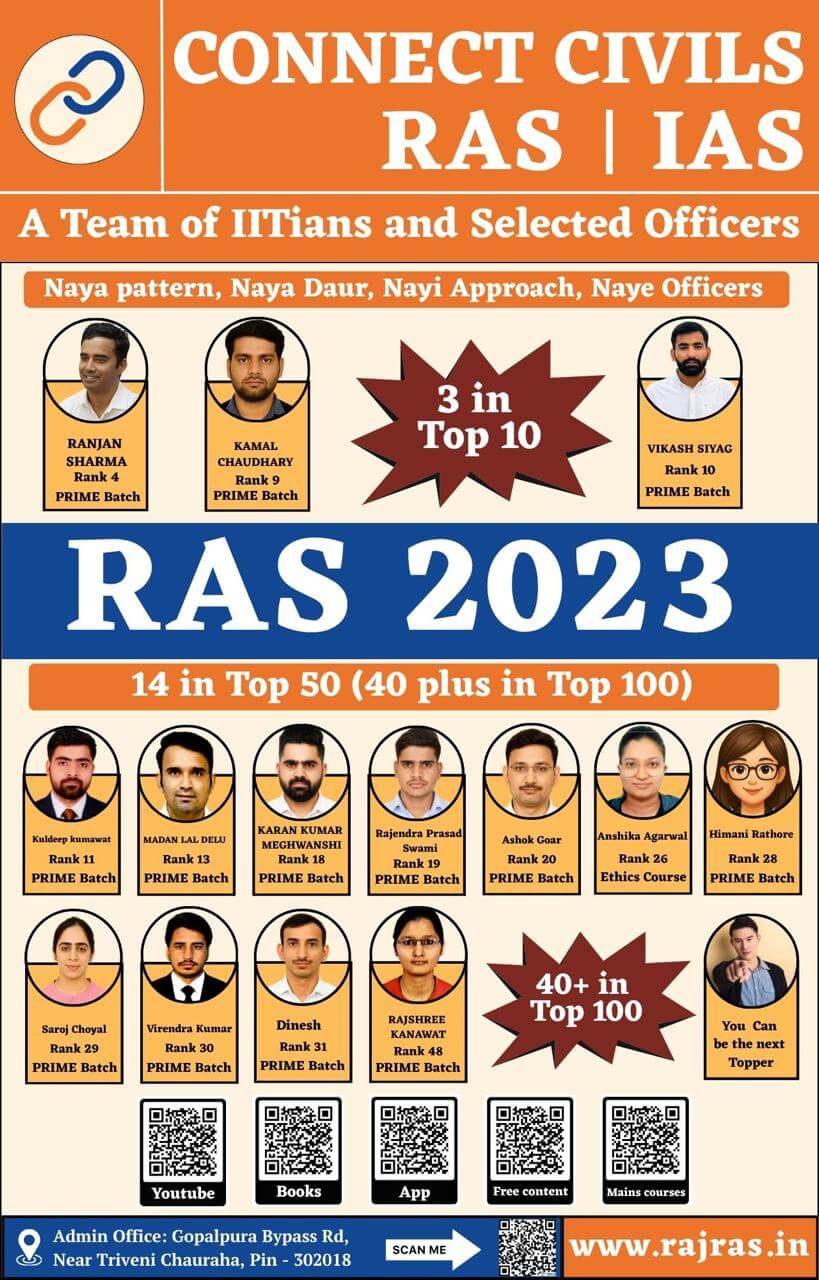The Formation of Rajasthan is an important chapter in Rajasthan History, showcasing the complex process of unifying 19 princely states and 3 chiefships into a single state.
In this chapter, we will explore the early efforts to form a union and the contributions of rulers such as Mewar’s Maharana Bhupal Singh, Jaipur’s Maharaja Mansingh, Kota’s Maharao Bhim Singh, and Dungarpur’s Maharawal Lakshman Singh. We will also study the stages of Rajasthan’s formation, the seven phases of unification, and key developments like the merger of Ajmer and the merger of Sirohi into Rajasthan.
Formation of Rajasthan
Before Independence, Rajasthan was Rajputana consisting of twenty-two small and big Princely States. On 5th July 1947 the State Secretariat was established with V. K Menon as its Secretary. In August 1947, at the time of Independence, Rajasthan included 19 princely states & 3 thikanas (Chiefships) of Neemrana, Lava & Kushalgarh. Though these Princely States were declared to have been annexed to the Union of India on 15 August, 1947, the process of merger and their unification became completed in November,1956, in 7 stages/phases.
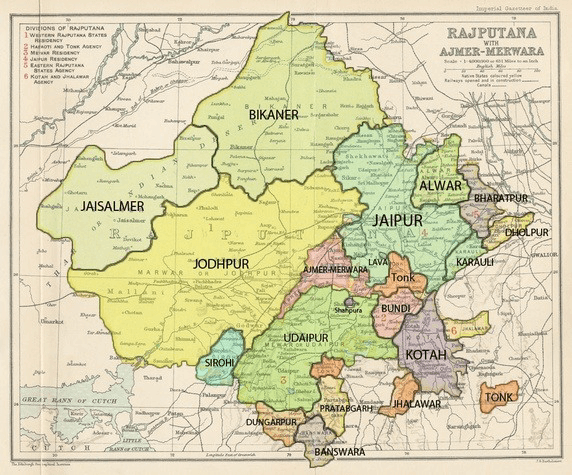
Earlier Efforts to form Union
Efforts by Mewar Maharana Bhupal Singh :
- He made the first attempt to form the ‘Rajasthan Union’ by uniting small states.
- In June 1946, he convened a conference in Udaipur with 22 kings from Rajasthan, Gujarat, and Malwa, where the idea of forming a union was discussed, where states could maintain their independence while sharing certain matters.
- He appointed K.M. Munshi as his constitutional advisor. On Munshi’s advice, a second conference was held in May 1947, where most of the states (except Jaipur, Jodhpur, Bikaner) agreed in principle but could not reach a unanimous decision.
- In February 1948, the draft of the proposed constitution was presented, which gave equal status to the rulers of all states. The proposal included the formation of an executive body, with all rulers as members, who would elect one of them as president for a term of three years. The constitution also provided for a bicameral legislature, where one house would have an equal number of representatives from each state, and the other house would have members elected based on the population ratio.
- But due to the lack of unity among the states, this plan failed. In March 1948, another appeal was made, but no concrete results were achieved.
Jaipur’s Maharaja Mansingh and the Union
- He also attempted to unite the small states of Rajasthan.
- In July 1947, after the announcement of new criteria by the Riyasati Secretariat, V.T. Krishnamachari, the Dewan of Jaipur, called for a conference.
- The proposal was that issues like law, education, and police would come under the control of the union, while the remaining matters would be under the control of individual states.
- However, there was no agreement among the kings in this conference, and this attempt also failed.
Maharao Bhim Singh’s Efforts in Kota
- Kota Maharao Bhim Singh tried to create the ‘Hadoti Union‘ by uniting the states of Kota, Bundi, and Jhalawar.
- However, due to mutual distrust and the desire for independence, this plan also failed.
Efforts by Dungarpur Maharawal Lakshman Singh
- Dungarpur Maharawal Lakshman Singh proposed the creation of the ‘Bagad Union’, which was to include the states of Dungarpur, Banswara, Kushalgarh, and Pratapgarh.
- However, due to rivalry and the desire for independence, this attempt also did not succeed.
Despite the efforts of Maharana Bhupal Singh (Mewar), Maharaja Mansingh (Jaipur), Maharav Bhim Singh (Kota), and Maharawal Lakshman Singh (Dungarpur), the formation of the ‘Rajasthan Union’ could not be achieved. Mutual distrust among the rulers, competition for power, and the desire for independence led to the failure of these efforts.
Stage of formation of Rajasthan
First Phase (18 March 1948) : Establishment of Matsya Union
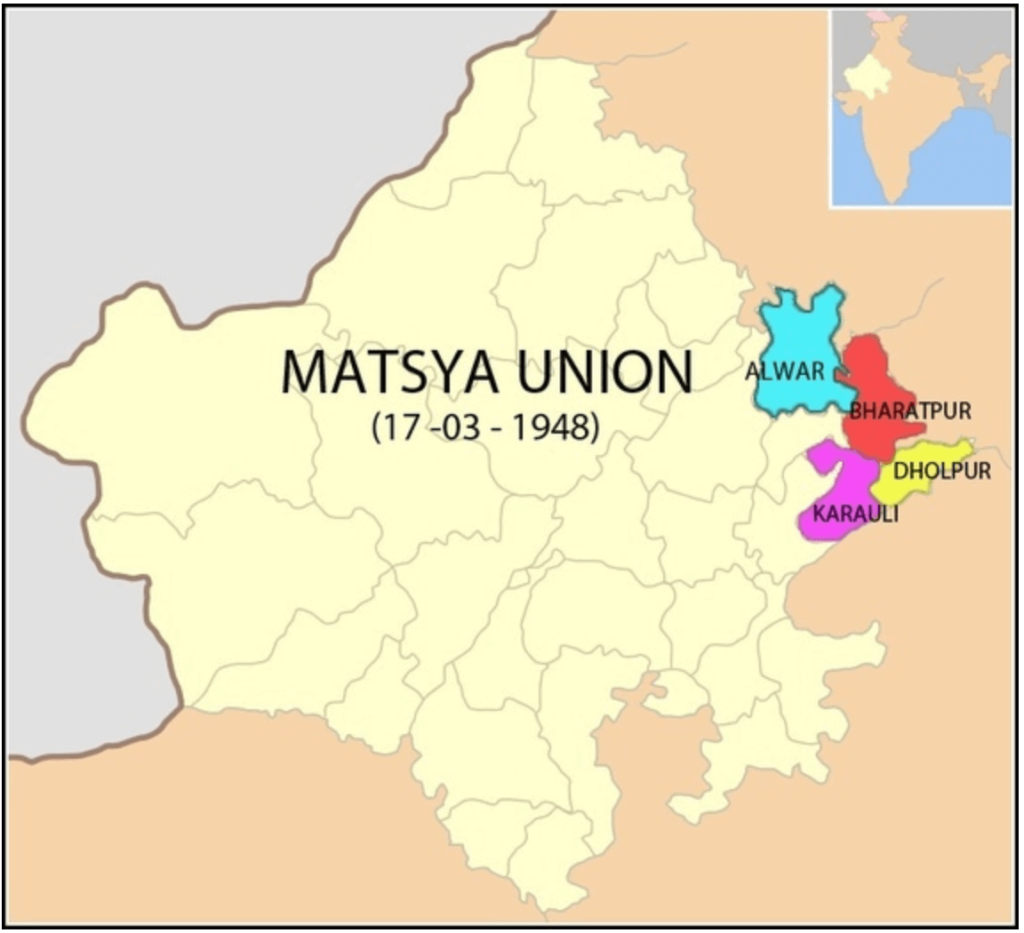
The Matsya Union was established on 18 March 1948 by integrating the princely states of Alwar, Bharatpur, Dholpur, and Karauli. The inauguration was done by the then Central Minister of Mines and Power, Shri Narhari Vishnu Gadgil (NV Gadgil). Alwar was made the capital, and Maharaja Udaybhan Singh of Dholpur was appointed as the Rajpramukh. The area of the Matsya Union was approximately 30,000 km², with a population of about 1.9 million and an annual income of ₹1.83 crore. It was written in the merger agreement that the union would later merge into Rajasthan.
- Naming of Matsya Union: K. M. Munshi
- Princely States: Alwar, Bharatpur, Dholpur, Karauli
- Thikana: Neemrana (Alwar)
- Capital: Alwar
- Rajpramukh: Udaybhan Singh (Dholpur)
- Deputy Rajpramukh: Ganesh Pal Singh (Karauli)
- Prime Minister: Shobharam Kumawat
- Deputy Prime Minister: Jugal Kishore Chaturvedi
- Inaugurator: Shri Narhari Vishnu Gadgil (NV Gadgil)
- Inauguration Location: Lohagarh (Bharatpur)
Hameedullah Khan, the President of Narendra Mandal, wanted to make Alwar and Bharatpur part of Mevistan. After independence, Dungarpur, Bharatpur, Jodhpur, and Alwar decided not to merge with anyone initially.
Second Phase (25 March 1948) : Formation of Rajasthan Union / Eastern Rajasthan
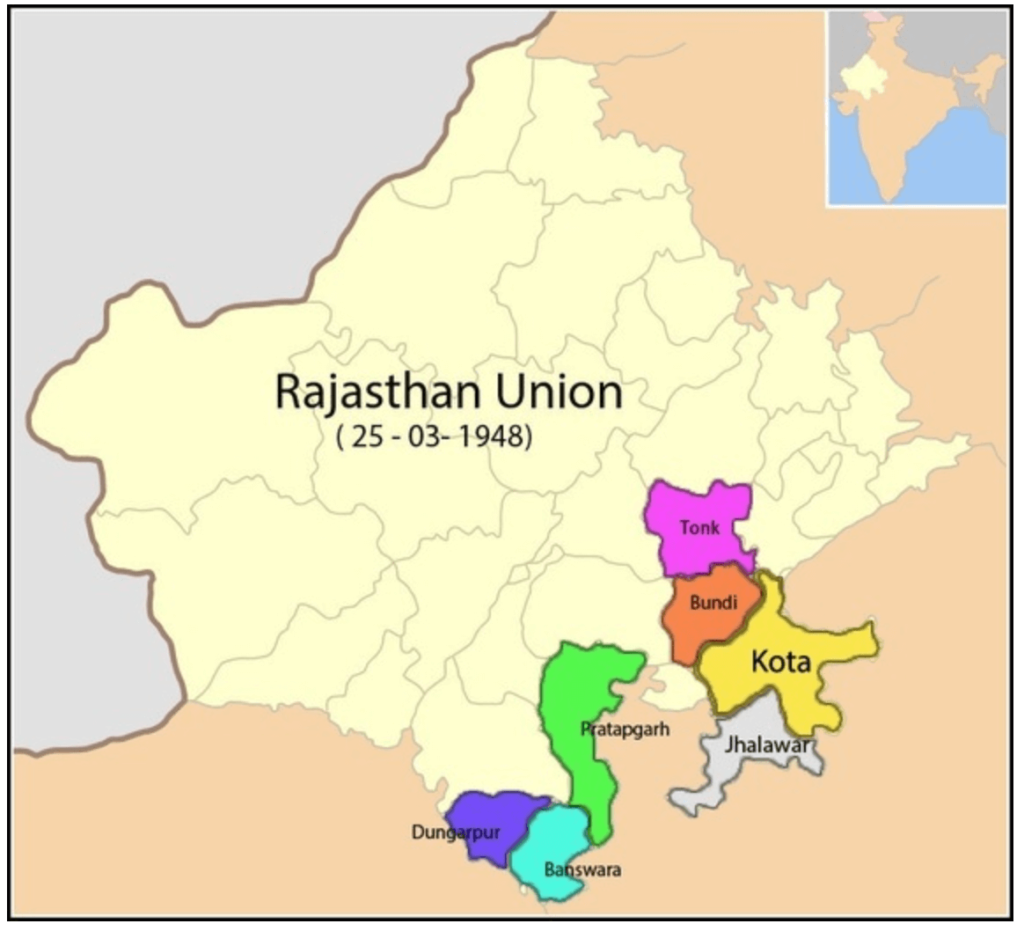
In the second phase, on 25 March 1948, the princely states of Kota, Bundi, Jhalawar, Tonk, Kishangarh, Pratapgarh, Dungarpur, Banswara, and Shahpura were merged to form Eastern Rajasthan. Kota was made the capital, and Maharaja Bhim Singh of Kota was appointed as the Rajpramukh. The inauguration was done by Shri Narhari Vishnu Gadgil. Maharaja Bahadur Singh of Bundi convinced the Udaipur state to merge with the Rajasthan Union. The intent was that, due to Udaipur being a large state, Maharana of Udaipur would be made Rajpramukh, and Maharaja Bahadur Singh would avoid serving under his younger brother, Maharaja Bhim Singh. Shahpura and Kishangarh opposed merging into Ajmer-Merwara. At the time of signing the merger document, Maharawal Chandraveer Singh of Banswara said, “I am signing my death warrant.“
- Princely States: Dungarpur, Banswara, Pratapgarh, Kota, Bundi, Tonk, Jhalawar, Kishangarh, Shahpura (9 states + 1 Thikana)
- Thikana: Kushalgarh (Banswara)
- Capital: Kota
- Rajpramukh: Maharaja Bhim Singh (Kota)
- Senior Rajpramukh: Bahadur Singh (Bundi)
- Junior Rajpramukh: Laxman Singh (Dungarpur)
- Prime Minister: Gokul Lal Asawa
- Inaugurator: Shri Narhari Vishnu Gadgil (NV Gadgil)
Third Phase (18 April 1948) : United Rajasthan
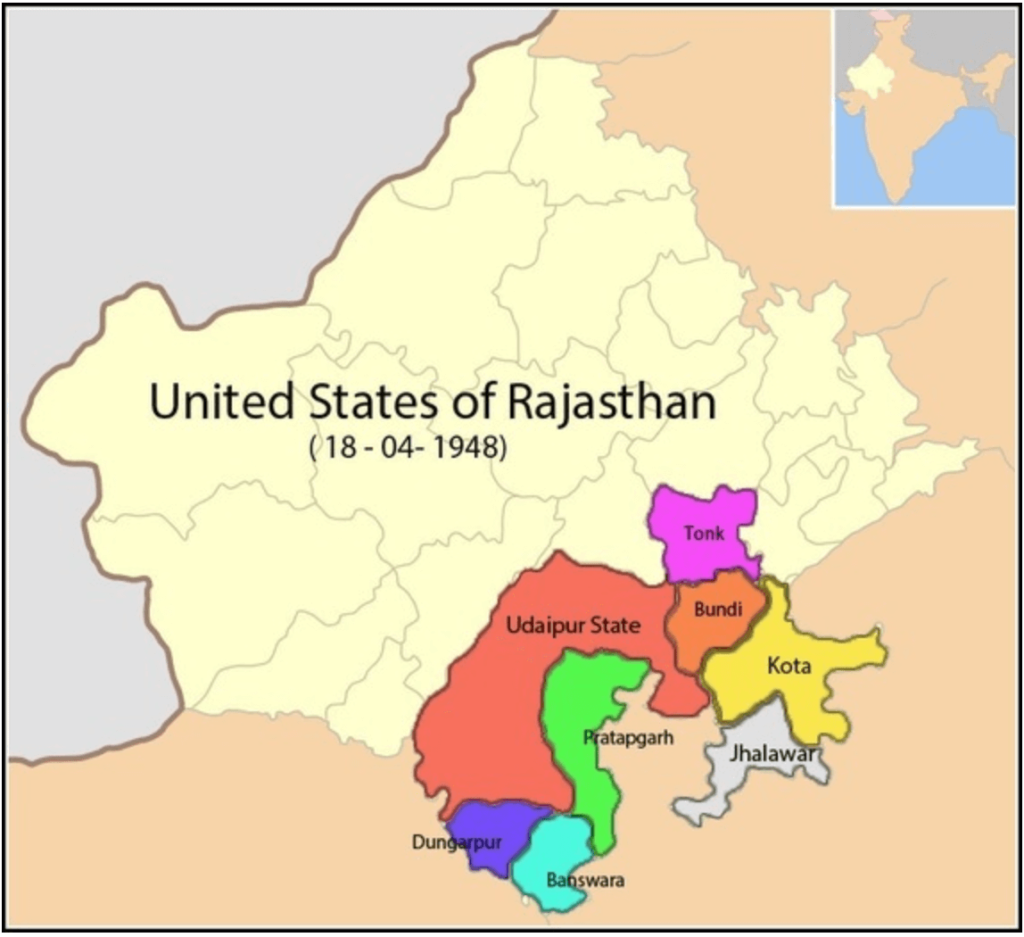
In the third phase, the princely state of Udaipur was merged with Eastern Rajasthan to form United Rajasthan on 18 April 1948. Udaipur was made the capital, and Maharana Bhupal Singh of Mewar was appointed as the Rajpramukh. Maharaja Bhim Singh of Kota was made Deputy Rajpramukh. A ministry under the leadership of Manikya Lal Verma was formed. The inauguration was done by the first Prime Minister of India, Pandit Jawaharlal Nehru, on 18 April 1948 in Udaipur. It was decided that one session of the Assembly would be held in Kota each year, and special efforts would be made for Kota’s development. Maharana Bhupal Singh of Mewar was granted a privy purse of ₹20 lakh. Maharana Bhupal Singh of Udaipur was the only physically challenged ruler at the time of integration.
- United Rajasthan: Rajasthan Union + Udaipur (10 states + 1 Thikana)
- Capital: Udaipur
- Rajpramukh: Maharana Bhupal Singh (Mewar)
- Senior Rajpramukh: Maharaja Bhim Singh (Kota)
- Junior Rajpramukh: Bahadur Singh (Bundi), Laxman Singh (Dungarpur)
- Prime Minister: Manikya Lal Verma
- Deputy Prime Minister: Gokul Lal Asawa
- Inaugurator: Pandit Jawaharlal Nehru
Fourth Phase : Greater Rajasthan (30 March 1949)
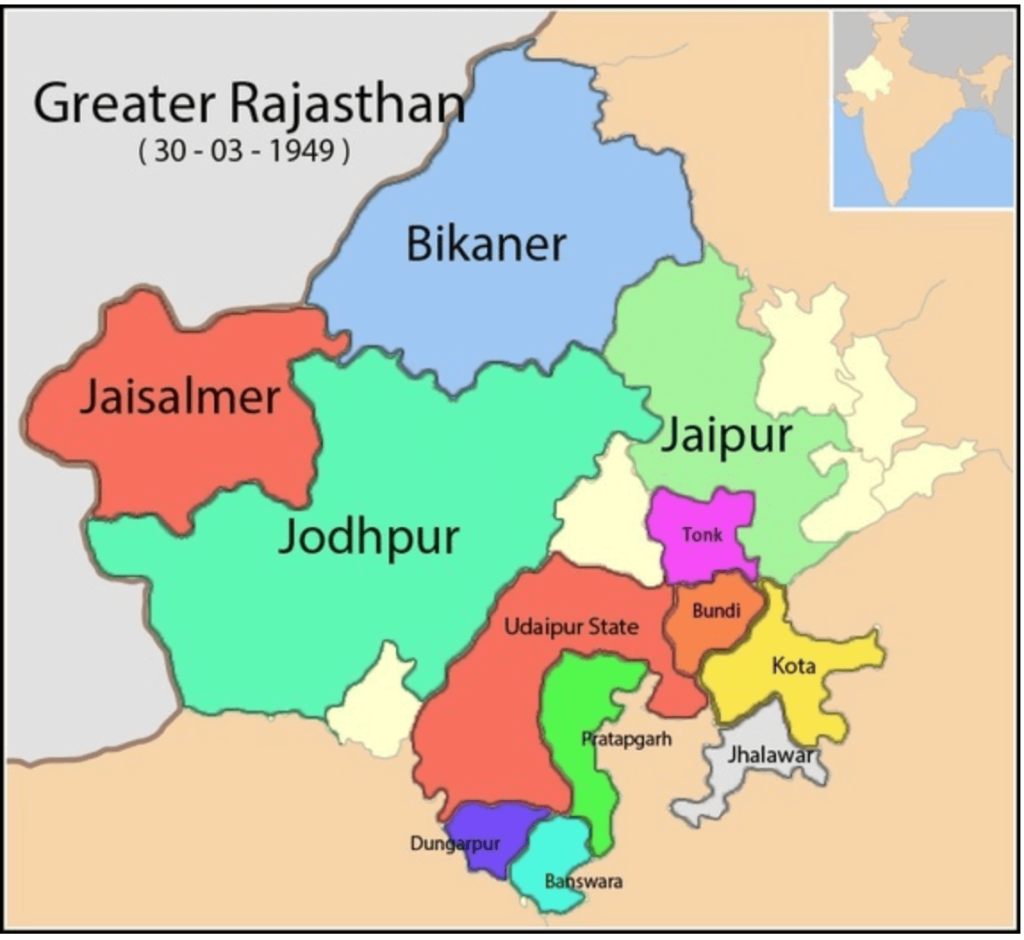
In the fourth phase of Rajasthan’s integration process, on 14 January 1949, Sardar Vallabhbhai Patel announced in Udaipur the theoretical inclusion of the princely states of Jaipur, Bikaner, Jodhpur, Lava, and Jaisalmer into Greater Rajasthan. Bikaner was the first state to merge into India. This decision was formalized on 30 March 1949 in a ceremony held in Jaipur, inaugurated by Sardar Vallabhbhai Patel. He also inaugurated the City Palace (Jaipur). Jaipur was made the capital, and Maharana Bhupal Singh of Udaipur was made the Maharajpramukh. Sawai Man Singh of Jaipur was made the Rajpramukh, and Maharaja Bhim Singh of Kota was made the Deputy Rajpramukh. After the existence of Greater Rajasthan, 30 March was declared Rajasthan Day.
- Rajasthan Day: 30 March
- Greater Rajasthan: United Rajasthan + Jaipur, Jodhpur, Jaisalmer, Bikaner, Lava (Thikana) (14 states + 2 Thikanas)
- Capital: Jaipur
- Maharajpramukh: Maharana Bhupal Singh (Udaipur, Mewar)
- Senior Rajpramukh: Hanwant Singh (Jodhpur), Bhim Singh (Kota)
- Rajpramukh: Sawai Man Singh (Jaipur)
- Junior Rajpramukh: Jawahar Singh (Bundi), Laxman Singh (Dungarpur)
- Prime Minister: Heeralal Shastri
- Inaugurator: Sardar Vallabhbhai Patel
In the fourth phase of Rajasthan integration, five departments were established:
- Education Department: Bikaner
- Justice Department: Jodhpur
- Forest Department: Kota
- Agriculture Department: Bharatpur
- Mining Department: Udaipur
During this phase, the princely states were granted privy purses as follows:
- Jaipur: ₹18 lakh
- Jodhpur: ₹17.5 lakh
- Bikaner: ₹17 lakh
- Jaisalmer: ₹1.80 lakh
Some important points:
- A dispute arose over making Jaipur or Jodhpur the capital. To resolve this, Sardar Vallabhbhai Patel formed the Committee in which B.R. Patel, Colonel T.C. Puri, S.P. Sinha and P. Satyanarayana Rao were included . The committee recommended Jaipur as the capital.
- Ram Manohar Lohia formed the Rajasthan Movement Committee, which demanded the early merger of the remaining princely states.
Fifth Phase : Unified Greater Rajasthan (May 15, 1949)
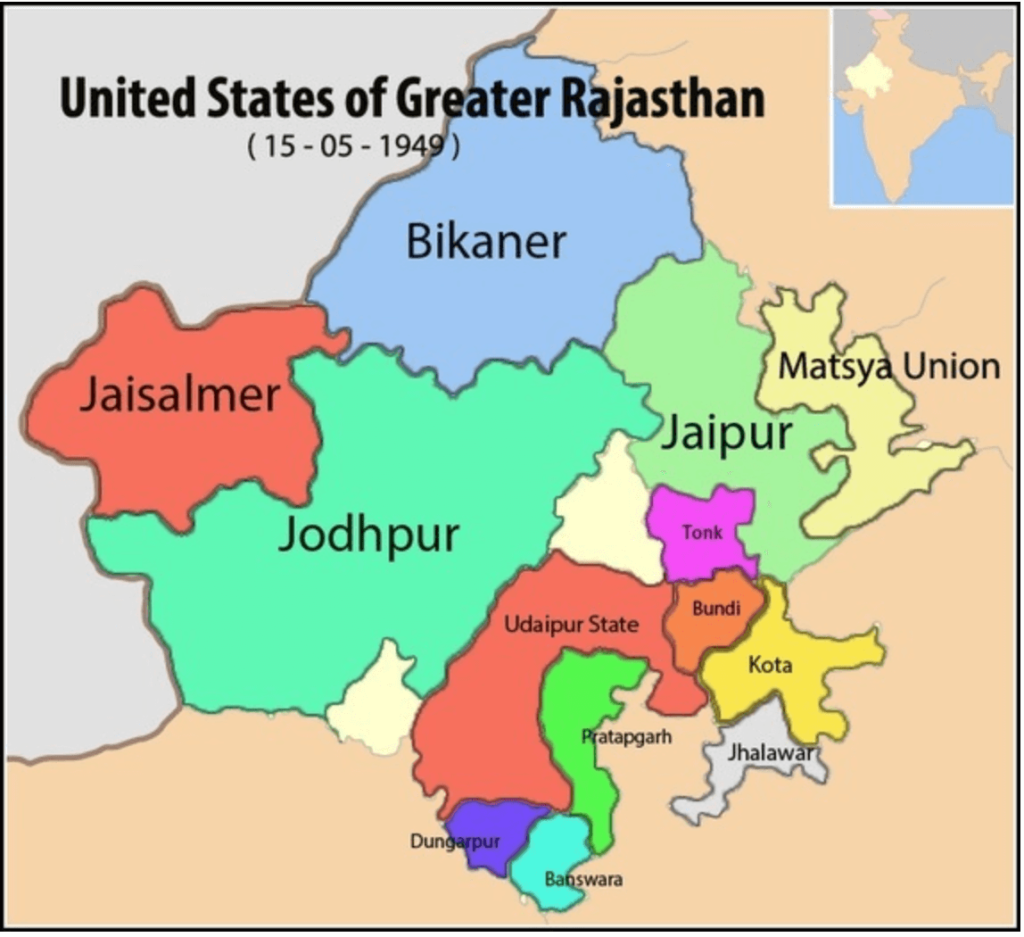
On May 15, 1949, following the recommendations of the Shankar Rao Dev Committee, the Matsya Union was merged into Greater Rajasthan, creating Unified Greater Rajasthan. Neemrana was also included. The committee members were R.K. Singhya and Prabhudayal. Sardar Vallabhbhai Patel formed this committee to gauge public opinion in light of the opposition from Bharatpur and Dholpur.
- Unified Greater Rajasthan: Matsya Union + Greater Rajasthan
- Prime Minister: Hiralal Shastri
- Rajpramukh: Sawai Man Singh (Jaipur)
- Capital: Jaipur
Sixth Phase : Present Rajasthan (January 26, 1950)
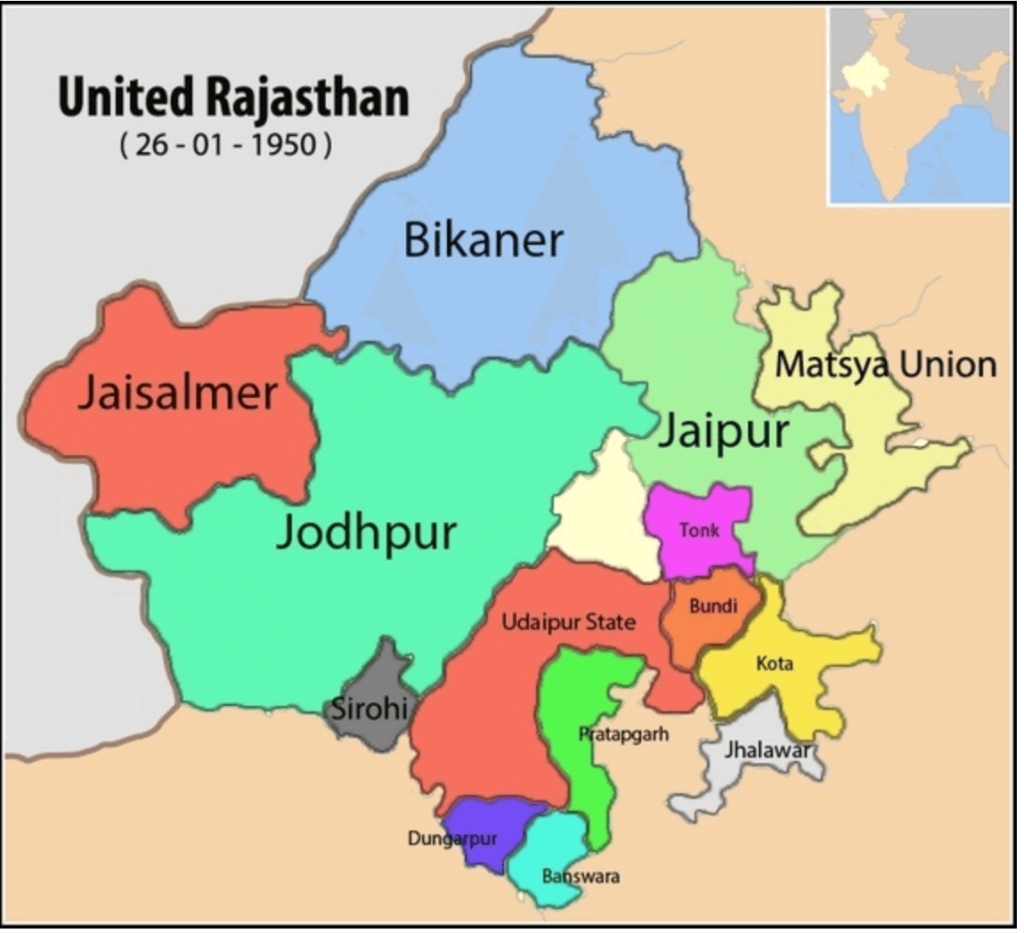
During the process of Rajasthan’s unification, the ruler of Sirohi was a minor. The administration was overseen by an agency council under the chairmanship of the Maharani of Dungarpur. Due to disputes over Abu-Delwara, 89 villages, including Hatak (Gokul Lal Asawa’s village), were merged into the Bombay Province. The remaining Sirohi was merged into Unified Greater Rajasthan on January 26, 1950, and renamed “Rajasthan.” On this date, Rajasthan was classified as a “Category B” state.
- Rajpramukh: Sawai Man Singh (Jaipur)
- Capital: Jaipur
- Prime Minister/Chief Minister: Hiralal Shastri (First Nominated Chief Minister)
Merger of Sirohi into Rajasthan
- In 1948, Hiralal Shastri wrote a letter to Sardar Patel demanding the merger of Sirohi into Rajasthan. In the same year, during the inauguration of United Rajasthan in Udaipur, Congress workers also appealed to Pandit Nehru regarding this matter. Pandit Nehru then wrote a letter to Sardar Patel, suggesting that the sentiments of the people regarding Sirohi should be taken into consideration.
- Sardar Patel initially intended to merge Sirohi into Maha Gujarat, and on 1st February 1948, Sirohi was removed from the Rajputana Agency and placed under the Western Indian States Agency of the Bombay Province. Following this, the administration of Sirohi was handed over to the Bombay government. Meanwhile, continuous movements were being carried out in Rajasthan to merge Sirohi back into the state.
Gujarat’s Argument:
- Gujarati Jains visit Mount Abu throughout the year to worship at the Jain temples.
- The culture of Mount Abu aligns more with Gujarat.
- The royal family of Sirohi had strong ties with the royal families of Kathiawar and Kutch in Gujarat.
- The people of Sirohi speak the Gujarati language.
Rajasthan’s Argument:
- Rajasthan’s leaders argued that Gujarati speakers were not in the majority in Sirohi.
- Sirohi had been a part of Rajputana for centuries.
- The language and culture of Sirohi were more similar to Rajasthan.
- Mount Abu should be included in Rajasthan as it is the only hill station in the state.
- On 26th January 1950, Sardar Patel divided Sirohi into two parts. Abu and Delwara tehsils (covering 89 villages and 304 square miles) were merged into the Bombay Province, while the remaining Sirohi was retained in Rajasthan.
- However, opposition to this division continued in Rajasthan. There was also a struggle for the throne of Sirohi, which further delayed the merger process. On 10th March 1949, a committee was formed to resolve the issue of succession, with the rulers of Jaipur and Kota as its members.
- In November 1956, based on the recommendations of the State Reorganization Commission, it was decided to merge Abu Road and Delwara tehsils back into Rajasthan. With this decision, the complete merger of Sirohi into Rajasthan was finalized, thus rectifying the previous injustice.
Seventh Phase : Reorganization of Rajasthan (November 1, 1956)
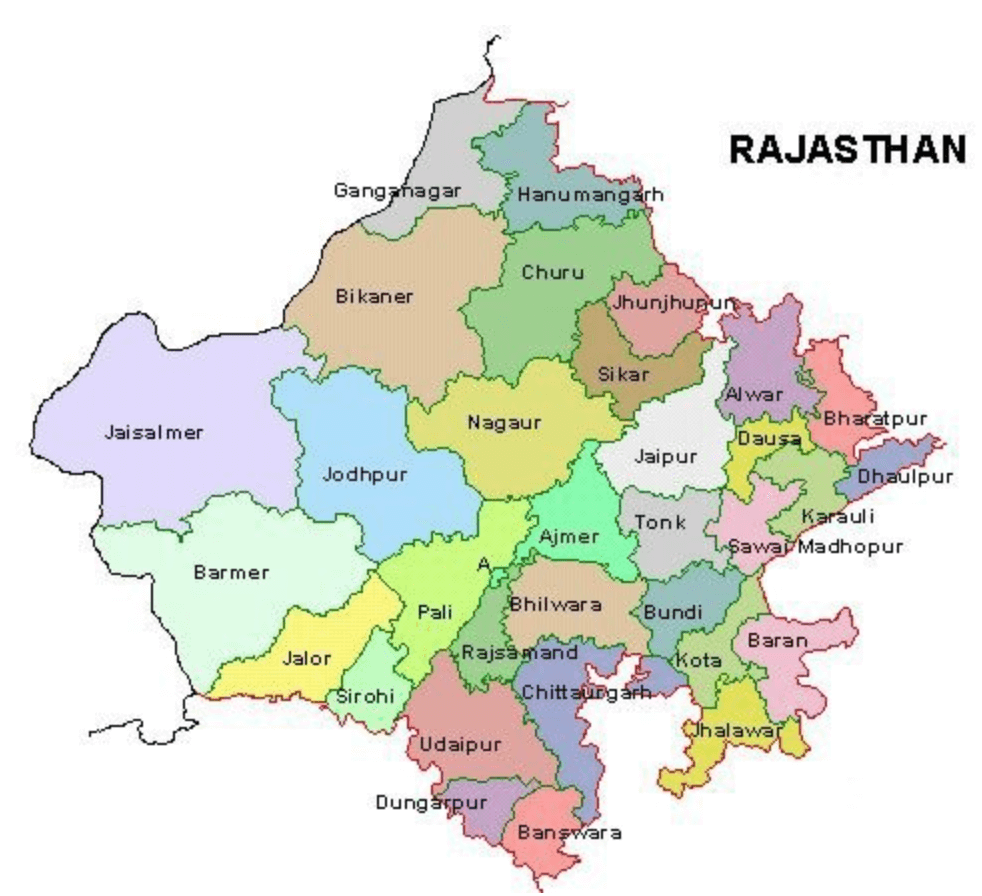
Based on the recommendations of the States Reorganization Commission (members Fazal Ali, Hridaynath Kunzru, K.M. Panikkar), the States Reorganization Act was implemented on November 1, 1956. Ajmer-Merwara, Abu tehsil, and other areas were merged into Rajasthan. Some adjustments were made, such as merging the Sunel Tappa region into Jhalawar district and transferring Sironj to Madhya Pradesh. Rajasthan assumed its current form on November 1, 1956. The Act ended the distinction between categories A, B, and C states, abolishing the positions of Rajpramukh and Maharajpramukh, and creating the Governor position.
- Capital: Jaipur
- Rajpramukh: Bhupal Singh (Mewar)
- Prime Minister/Chief Minister: Hiralal Shastri
Ajmer’s Merger
The Rajasthan Assembly consistently demanded Ajmer’s inclusion in Rajasthan. However, Congress leaders from Ajmer argued that smaller states were better for administration. The States Reorganization Commission dismissed this argument and recommended Ajmer’s merger into Rajasthan, finalizing the unification process in November 1956.
Summary: Stages of Rajasthan State Formation
| S.No | Name of Group | States | Date of Integration | Chief Minister | Governor |
| 1 | Matsya Union | Alwar, Bharatpur, Dholpur, Karauli | 17-03-1948 | Shri Shobha ram | Rajpramukh: Maharaj rana Udaibhan Singh of Dholpur |
| 2 | Rajasthan Union | Banswara, Bundi, Dungerpur, Jhalawar, Kishangarh, Kota(Capital), Pratapgarh, Shahpura, Tonk. | 25-03-1948 | Gokul Ll Asawa | Rajpramukh: Kota Naresh – Maharao Bhim Singh |
| 3 | United State of Rajasthan | Udaipur also joined with the other Union of Rajasthan. | 18-04-1948 | Manikhya Lal Verma | Rajpramukh: Maharana of Udaipur – Bhupal Singh UprajyaPramukh: Kota Naresh |
| 4 | Greater Rajasthan | Bikaner, Jaipur, Jaisalmer & Jodhpur also joined with the United State of Rajasthan. | 30-03-1949 | Hiralal Shastri (1st CM) (7/4/1949) | Rajpramukh:Raja Man Singh (II) of Jaipur. But as Udaipur Maharana senior hence, Udaipur Maharana designated as Maharajpramukh |
| 5 | United State of Greater Rajasthan | Matsya Union also merged in Greater Rajasthan | 15-05-1949 | ||
| 6 | United Rajasthan | 18 States of United Rajasthan merged with Princely State Sirohi except Abu and Delwara. | 26-01-1950 | ||
| 7 | Re-organised Rajasthan | Under the State Re-organisation Act, 1956 the erstwhile part ‘C’ State of Ajmer, Abu Road Taluka, former part of princely State Sirohi which was merged in former Bombay, State and Sunel Tappa region of the former Madhya Bharat merged with Rajasthan and Sironj subdistrict of Jhalawar district was transferred to Madhya Pradesh. | 11/01/56 | C. S Ventachari (6/1/1951) Jai Narayan Vyas (26/4/1951) Tikaram Paliwal (3/3/1952) Jainarayan Vyas (1/11/1952) Mohan lal Sukhadia ( 13/11/54) till 67 | Mann Singh ji continued till 31/10/56 when Gurumukh Nihal Singh became Governor (1/11/1956) |
FAQ (Previous year questions)
Initial Demand for Merger (1948)
In 1948, Hiralal Shastri wrote to Sardar Patel requesting the merger of Sirohi into Rajasthan.
During the inauguration of United Rajasthan in Udaipur (same year), Congress workers also appealed to Pandit Nehru to consider the people’s sentiments.
Nehru then wrote to Sardar Patel, urging him to consider these sentiments in the decision.
Patel’s Initial Plan (1948)
Sardar Patel initially planned to merge Sirohi with Maha Gujarat.
On 1st February 1948, Sirohi was removed from the Rajputana Agency and placed under the Western Indian States Agency of Bombay Province.
Opposition and Movements
Rajasthan witnessed continuous protests demanding Sirohi’s merger with Rajasthan, despite Patel’s decision.
People in Rajasthan strongly opposed the separation of Sirohi from the state.
Division of Sirohi (1950)
On 26th January 1950, Sardar Patel divided Sirohi into two parts:
Abu and Delwara tehsils (covering 89 villages and 304 square miles) were merged into Bombay Province.
The remaining part of Sirohi stayed with Rajasthan.
The division faced opposition in Rajasthan, and people continued to push for full reintegration.
Succession Issues and Delays
Succession disputes delayed the merger further. A committee with the rulers of Jaipur and Kota was formed on 10th March 1949 to resolve these issues.
Final Integration of Sirohi (1956)
In November 1956, following the State Reorganization Commission’s recommendations, Abu Road and Delwara tehsils were finally merged with Rajasthan, completing Sirohi’s integration into the state.

